
Tea is an aromatic beverage prepared by pouring hot or boiling water over cured or fresh leaves of Camellia sinensis, an evergreen shrub native to East Asia which probably originated in the borderlands of southwestern China and northern Myanmar. Tea is also made, but rarely, from the leaves of Camellia taliensis. After plain water, tea is the most widely consumed drink in the world. There are many different types of tea; some have a cooling, slightly bitter, and astringent flavour, while others have profiles that include sweet, nutty, floral, or grassy notes. Tea has a stimulating effect in humans primarily due to its caffeine content.
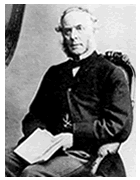
Robert Fortune was a Scottish botanist, plant hunter and traveller, best known for introducing around 250 new ornamental plants, mainly from China, but also Japan, into the gardens of Britain, Australia, and the USA. He also played a role in the development of the tea industry in India in the 19th century.

White tea may refer to one of several styles of tea which generally feature young or minimally processed leaves of the Camellia sinensis plant.
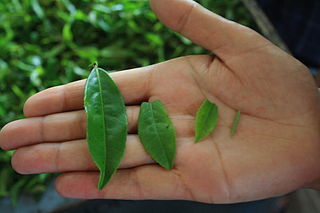
In the tea industry, tea leaf grading is the process of evaluating products based on the quality and condition of the tea leaves themselves.

Camellia sinensis is a species of evergreen shrub or small tree in the flowering plant family Theaceae. Its leaves and leaf buds are used to produce black and green tea. Common names include tea plant, tea shrub, and tea tree.

Assam tea is a black tea named after the region of its production, Assam, India. It is manufactured specifically from the plant Camellia sinensis var. assamica (Masters). The Assam tea plant is indigenous to Assam—initial efforts to plant the Chinese varieties in Assam soil did not succeed. Assam tea is now mostly grown at or near sea level and is known for its body, briskness, malty flavour, and strong, bright colour. Assam teas, or blends containing Assam tea, are often sold as "breakfast" teas. For instance, Irish breakfast tea, a maltier and stronger breakfast tea, consists of small-sized Assam tea leaves.
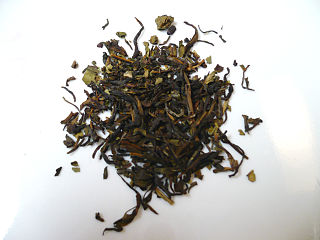
Nilgiri tea is a drink made by infusing leaves of Camellia sinensis that is grown and processed in the Nilgiris district in Tamil Nadu, India. The leaves are processed as black tea, though some estates have expanded their product offerings to include leaves suitable for making green, white and oolong teas. It is generally described as being a brisk, fragrant and full-bodied tea. The region produces both rolled and crush, tear, curl tea and it is predominantly used for blending. Nilgiri tea is also used for making iced tea and instant tea.
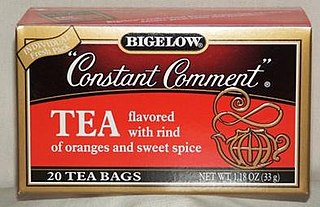
R.C. Bigelow, Inc. is an American manufacturer of dried teas based in Fairfield, Connecticut. It was founded by Ruth C. Bigelow in 1945, based on a recipe she marketed as "Constant Comment" tea. The company markets over 50 varieties of tea, including black, green and herbal, all of which are blended in Fairfield. The company has other plants in Boise, Idaho, and Louisville, Kentucky. Their Charleston Tea Garden in South Carolina is the only tea garden in America, but it does not produce the company's teas. Still a 100% family-owned business, Bigelow employs 350 people and had annual sales in 2020 of approximately US$188.9 million.

The history of tea spreads across multiple cultures over the span of thousands of years. With the tea plant Camellia sinensis native to East Asia and probably originating in the borderlands of southwestern China and northern Myanmar. One of the earliest accounts of tea drinking is dated back to China's Shang dynasty, in which tea was consumed as a medicinal drink. An early credible record of tea drinking dates to the 3rd century AD, in a medical text written by Chinese physician Hua Tuo. It first became known to the western world through Portuguese priests and merchants in China during the early 16th century. Drinking tea became popular in Britain during the 17th century. The British introduced commercial tea production to British India, in order to compete with the Chinese monopoly on tea.
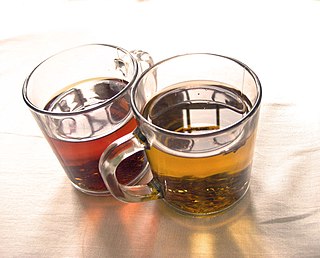
Nepali tea is a beverage made from the leaves of tea plants grown in Nepal. They are distinctive in appearance, aroma and taste, but are similar in many ways to tea produced in Darjeeling tea, perhaps because the eastern zones of Nepal have geography and topography similar to Darjeeling. Its relatively smaller production quantities mean that teas from Nepal are less well known than those from Darjeeling.

Darjeeling tea is a tea made from Camellia sinensis var. sinensis that is grown and processed in Darjeeling district or Kalimpong district in West Bengal, India. Since 2004, the term Darjeeling tea has been a registered geographical indication referring to products produced on certain estates within Darjeeling and Kalimpong. The tea leaves are processed as black tea, though some estates have expanded their product offerings to include leaves suitable for making green, white, and oolong teas.
Wadmalaw Island is an island located in Charleston County, South Carolina, United States. It is one of the Sea Islands, a chain of tidal and barrier islands on the Atlantic Ocean.
Camellia sinensis, the source of tea leaves and buds, can be grown in much of the United States. Commercial cultivation has been tried at various times and locations since the 1700s, but tea has remained a niche crop and has never been cultivated widely in the US. As of 2020, the US mainland has one relatively large plantation with full mechanization in Charleston, South Carolina, and many small commercial tea gardens that pick tea by hand. Some growers feel that tea production is not economically viable without some mechanization, but there is evidence that unmechanized tea production is viable, albeit with lower net profit margins. Most domestically grown teas are available through mail order and online purchases.

Magnolia Plantation and Gardens is a historic house with gardens located on the Ashley River at 3550 Ashley River Road west of Ashley, Charleston County, South Carolina. It is one of the oldest plantations in the South, and listed on the National Register of Historic Places. Magnolia Plantation is located near Charleston and directly across the Ashley River from North Charleston. The house and gardens are open daily; an admission fee is charged.

India is one of the largest tea producers in the world, although over 70 percent of its tea is consumed within India itself. A number of renowned teas, such as Assam and Darjeeling, also grow exclusively in India. The Indian tea industry has grown to own many global tea brands and has evolved into one of the most technologically equipped tea industries in the world. Tea production, certification, exportation and all facets of the tea trade in India are controlled by the Tea Board of India.
Firefly Distillery is a company located near Park Circle North Charleston, South Carolina, that produces a line of alcoholic beverages and licenses its brand name to the Sazerac Company for Firefly branded products produced elsewhere. Some Firefly branded products sold outside of South Carolina are actually produced in Kentucky by Sazerac rather than being produced by Firefly itself.
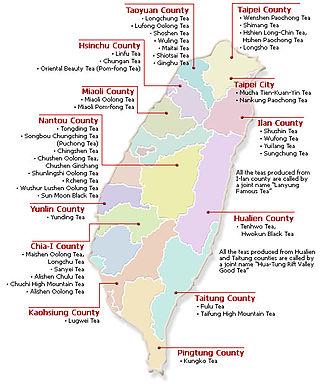
Taiwanese tea includes four main types: oolong tea, black tea, green tea and white tea. The earliest record of tea trees found in Taiwan is from 1717 in Shui Sha Lian (水沙連), present-day Yuchi and Puli, Nantou County. Some of the teas retain the island country's former name, Formosa.

Sri Lanka has a climate and varied elevation that allows for the production of both Camellia sinensis var. assamica and Camellia sinensis var. sinensis, with the assamica varietal holding the majority of production. Tea production is one of the main sources of foreign exchange for Sri Lanka, and accounts for 2% of GDP, contributing over US$1.3 billion in 2021 to the economy of Sri Lanka. It employs, directly or indirectly, over 1 million people, and in 1995 directly employed 215,338 on tea plantations and estates. In addition, tea planting by smallholders is the source of employment for thousands whilst it is also the main form of livelihood for tens of thousands of families. Sri Lanka is the world's fourth-largest producer of tea. In 1995, it was the world's leading exporter of tea, with 23% of the total world export, and Sri Lanka ranked second on tea export earnings in 2020 after China. The highest production of 340 million kg was recorded in 2013, while the production in 2014 was slightly reduced to 338 million kg. India has additionally guaranteed Sri Lanka a shipment of 65,000 metric tons of urea. Sri Lanka's troubled execution of an organic agriculture initiative had pushed the country perilously close to an agricultural crisis. Given the surge in global fertilizer prices, it is improbable that Sri Lanka could procure fertilizer at prevailing market rates.

Kangra tea is a tea from the Kangra district in Himachal Pradesh, India. Both black tea and green tea have been produced in the Kangra Valley since the mid-19th century. Kangra tea was given the Geographical Indication status in 2005.
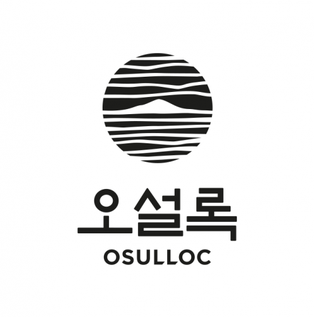
O'Sulloc Tea is a traditional Korean tea manufactured and sold by the South Korean company O'Sulloc. The company was founded in 1979 by Suh Sung-hwan. O'Sulloc Corporation was established in September 2020 as an independent subsidiary of the Amorepacific Corporation, with 100% ownership. O'Sulloc Tea originates from the cultivated fields on Jeju Island. It is also an internationally recognized brand in other countries such as China, Japan, and the United States. O'Sulloc teas consist of a range of black and green teas based on traditional Korean tea culture. O'Sulloc teas have various certifications, and in 2010 were certified with the National Organic Program (NOP) certification by the United States Department of Agriculture (USDA).



















